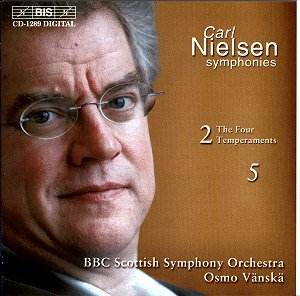This is the second release in this series. I
havenít heard the previous release, which received rave reviews
in the press, when it was released. My one overall view about
the current disc is that I wish Vänskä had recorded
his Nielsen series with the Lahti Symphony Orchestra rather than
the BBC Scottish Orchestra. It is not that there is anything wrong
with the current ensemble; it is just that I hear a slightly stilted
style of playing which, I am sure, would not have been audibly
present with the Finnish ensemble. Like British orchestras and
Elgar, there is a feeling of absolute rightness with Scandinavian
ensembles playing their own music. It must be something to do
with forests, or something else of this nature.
Given this slight shortcoming, what of the present
performances? The Four Temperaments gets off to a flying start,
with a headlong tempo, which is very exciting and exactly in the
spirit of the work. Very quickly, Vanska pulls back the tempo
much more than I feel he needs to, and then rushes off again in
a great hurry. This whole movement is characterised by many violent
tempo changes, which finds the orchestra a little uncomfortable,
although the brass section is having a field day.
This symphony was performed initially without
a detailed programme in 1902, conducted by the composer. It was
well received, but not with the rapture of some of his later works.
Many years later, Nielsen was asked to provide programme notes
for this symphony, and went into much greater detail. Evidently
in earlier years, before the completion of the symphony, Nielsen
had visited a country inn on Sjaelland. On the wall of the inn
was a comic picture, divided into four quarters, each section
depicting the various temperaments Ė choleric, sanguine, melancholic
and phlegmatic. The picture of the choleric figure, for example,
was riding a horse with a long sword in his hand that he was waving
wildly about in the air; his eyes seemed to be about to jump out
of his head and his hair was standing madly on end all around
his face, which was screwed up with anger and devilish hatred.
This caused the composer much merriment, and he used this and
the other three similarly comic pictures as the inspiration for
this symphony.
I am not so sure I can picture these scenes directly
in the music, but no matter. If they formed the basic inspiration
for the composer in writing this symphony, then so much the better.
By the time Nielsen wrote the Symphony No. 5,
generally considered to be his masterpiece, he was a much more
assured composer with a superb sense of movement and style. It
is unnamed, and is in two long movements. It basically deals with
the conflicts between opposing forces in nature. In this aspect,
it is basically similar to the implied programmes of the 2nd,
3rd and 4th Symphonies. In the 5th,
the tension comes in the form of a side drum with which the player
is instructed by the composer to disrupt progress by improvising
and causing as much chaos as possible. The orchestra has to concentrate
on what it is doing, and swamp the poor soloists with a wonderfully
uplifting melody for massed strings, brass and woodwind. I have
never heard a performance where the side drum is successful in
its efforts, but it has come close in a couple of live concerts.
Vänskäís performance is secure, as
you would expect, since if the side drum really had won, it would
be re-recorded to put things right. The second movement is a great
outpouring of joy, with a rumbustious fugue forming the central
part of the finale. This is played with the right amount of joy,
but there is still an inhibition there, not present in the superb
(mono) recording by the Danish Radio Symphony Orchestra on Dutton.
Here, the conductor (Thomas Jensen) has just the right amount
of flexibility and absolute control over his forces to make you
understand what this symphony is all about.
So, not up there with the best, but a very creditable
effort, superbly recorded and annotated by BIS. If you are collecting
this series, do not hesitate, but if you want to hear primeval
Nielsen at his greatest, go for the Dutton. Although the recording
is early fifties mono, you will be astonished by how much detail
you will be able to hear. The 5th is coupled with the
1st Symphony and the Helios Overture on Dutton CDLXT
2502, or better still on a Danacord release with a live set of
all six symphonies conducted by Launy Grøndahl, Thomas
Jensen and Erik Tuxen, the three pioneer conductors for this repertoire.
John Phillips

![]() BBC Scottish Symphony Orchestra/Osmo
Vänskä.
BBC Scottish Symphony Orchestra/Osmo
Vänskä.![]() BIS CD-1289 [71í23"]
BIS CD-1289 [71í23"]